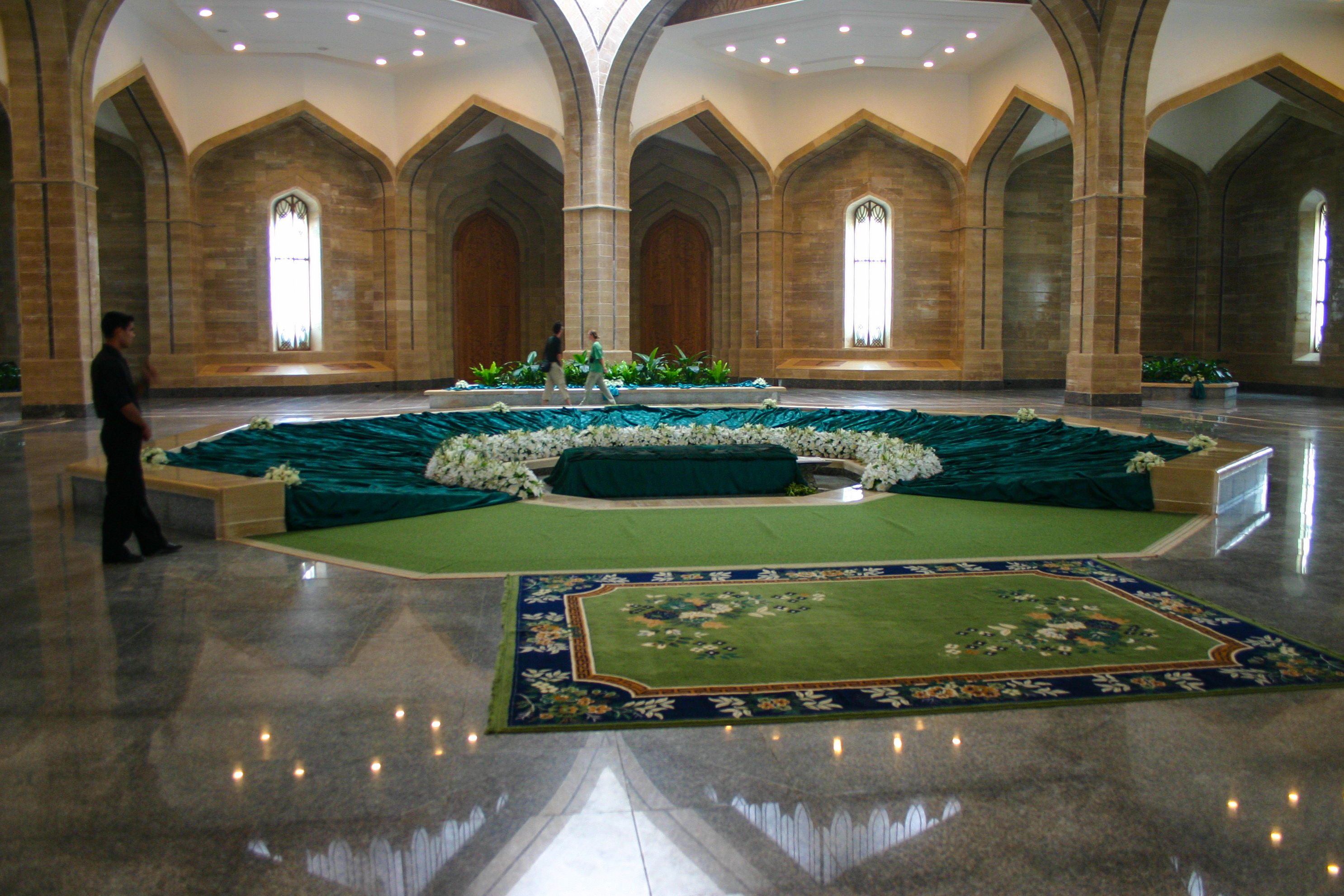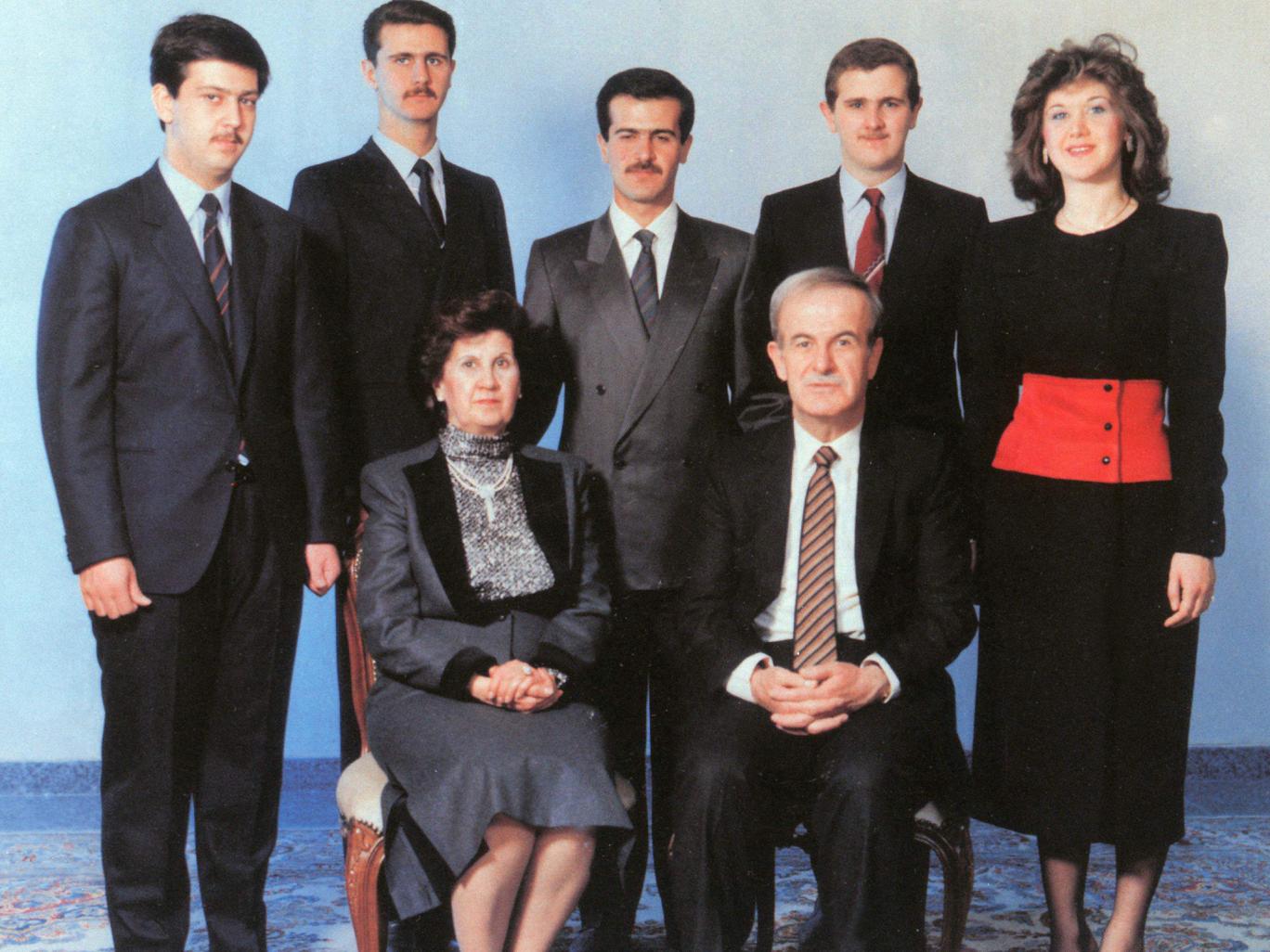|
Assad Mausoleum
Assad Mausoleum (), commonly known as Hafez al-Assad Mausoleum (), officially known as "Immortal Leader's Mausoleum" () during the Ba'athist regime, was the mausoleum of the Assad family, which ruled Syria from 1971 until 2024. It was mainly centered on the mausoleum of former President of Syria Hafez al-Assad and his eldest son Bassel al-Assad. The mausoleum was located in the village of Qardaha in Latakia Governorate, in the Syrian Coastal Mountains. The predominantly Alawite village was the traditional home of the Assad family. On 11 December 2024, after the fall of the Assad regime, the mausoleum was sacked by rebels. History The mausoleum stood at the land of Sheikh Ali al-Khayyir's house, which was 3 acres in size. Jamil al-Assad and Jaber Shalish forced al-Khayyir to sell the land for less than $200, and initially, they refused it. Since they were powerless, they handed over the land to Assad. Upon acquiring the land, Assad commissioned Military Housing Establishment ... [...More Info...] [...Related Items...] OR: [Wikipedia] [Google] [Baidu] |
Qardaha
Qardaha ( / ALA-LC: ''Qardāḥah'') is a town in northwestern Syria, in the mountains overlooking the coastal town of Latakia. Nearby localities include Kilmakho to the west, Bustan al-Basha to the southwest, Harf al-Musaytirah to the southeast and Muzayraa to the north. According to the Syrian Central Bureau of Statistics, Qardaha had a population of 8,671 in 2004.General Census of Population and Housing 2004 Syrian Central Bureau of Statistics (CBS). Latakia Governorate. It has a predominantly |
Jamil Al-Assad
Jamil al-Assad (; 1933 – 15 December 2004) was a younger brother of the late Syrian president Hafez al-Assad, and the uncle of former Syrian President Bashar al-Assad. He served in the People's Assembly of Syria from 1971 until his death in 2004. He was also commander of a minor militia. Activities While both his brothers, Hafez and Rifaat al-Assad, enforced secularism, Jamil was said to be deeply religious. During the 1980s, Jamil actively supported conversion to Shiism in the Latakia Mountains, especially among members of the Alawite community. He sent groups of Alawites to study Twelver Shiism in Iran. They made the Shiite creed common among their fellow Alawites upon their return to Syria. Jamil also built husayniyyas in the mountains, where before there had been only Alawite shrines. In order to make Shiism more acceptable there he appointed a Shiite sheikh to head the Alawite al-Zahra Mosque in the city of Baniyas. He also allowed Iranian officials to enter Syria to realize ... [...More Info...] [...Related Items...] OR: [Wikipedia] [Google] [Baidu] |
Gamal Abdel Nasser Mosque
The Gamal Abdel Nasser Mosque () is a mosque in Cairo, Egypt. The mosque is known for containing the mausoleum of Gamal Abdel Nasser. Overview It is located in El Qobbah district and as such, it is often referred to as "El-Qobbah Mosque". It is situated close to the building of the Ministry of Defence and Military Production, and the campus of Ain Shams University. Construction of the mosque begun in 1962, with the donation of the citizens of El Qobbah. In 1965, Nasser ordered the completion of the construction by financing the cost and supervising the design, which employs the Modern Arabic architectural style. The construction cost reached EGP 300,000. Several social activities take place in the mosque, including the Qur'anic learning, training for orphan girls and medical clinic. See also * Islam in Egypt Islam is the dominant religion in Egypt, with approximately 94.9% of Egyptians identifying as Muslims. The majority of Egyptian Muslims are adherents of Sunni I ... [...More Info...] [...Related Items...] OR: [Wikipedia] [Google] [Baidu] |
Mausoleum Of Ruhollah Khomeini
The Mausoleum of Ruhollah Khomeini (; ), also known as the Holy Shrine, or the ''Haram Motahhar'', is a Shi'ite Islamic mausoleum that houses the tombs of Ayatollah Ruhollah Khomeini, his wife Khadijeh Saqafi, and his second son Ahmad Khomeini; and some political figures, such as former President Akbar Hashemi Rafsanjani, former Vice President Hassan Habibi, Lieutenant General Ali Sayad Shirazi, Iranian Revolution figure Sadeq Tabatabaei, and MP Marzieh Hadidchi. The mausoleum is located to the south of Tehran in the Behesht-e Zahra (Paradise of Zahra) cemetery. The mausoleum is the centerpiece in a funerary complex spread over , that houses the tombs, a cultural and tourist center, a university for Islamic studies, a seminary, a shopping mall, a 20,000-car park, and a branch of the National Museum of Iran. Construction commenced in 1989 following Khomeini's death on 3 June of that year, took over 35 years to complete, and the Iranian government reportedly devoted 2 ... [...More Info...] [...Related Items...] OR: [Wikipedia] [Google] [Baidu] |
Arabic Calligraphy
Arabic calligraphy is the artistic practice of penmanship, handwriting and calligraphy based on the Arabic alphabet. It is known in Arabic language, Arabic as ''khatt'' (), derived from the words 'line', 'design', or 'construction'. Kufic is the oldest form of the Arabic script. From an artistic point of view, Arabic calligraphy has been known and appreciated for its diversity and great potential for development. In fact, it has been linked in Arabic culture to various fields such as Islam, religion, Islamic art, art, Islamic architecture, architecture, education and craftsmanship, which in turn have played an important role in its advancement. Although most Islamic calligraphy is in Arabic and most Arabic calligraphy is Islamic, the two are not identical. Coptic Orthodox Church of Alexandria, Coptic or other Christianity in the Middle East, Christian manuscripts in Arabic, for example, have made use of calligraphy. Likewise, there is Islamic Persian calligraphy, calligraphy in ... [...More Info...] [...Related Items...] OR: [Wikipedia] [Google] [Baidu] |
Quran
The Quran, also Romanization, romanized Qur'an or Koran, is the central religious text of Islam, believed by Muslims to be a Waḥy, revelation directly from God in Islam, God (''Allah, Allāh''). It is organized in 114 chapters (, ) which consist of individual verses ('). Besides its religious significance, it is widely regarded as the finest work in Arabic literature, and has significantly influenced the Arabic, Arabic language. It is the object of a modern field of academic research known as Quranic studies. Muslims believe the Quran was orally revealed by God to the final Islamic Prophets and messengers in Islam, prophet Muhammad in Islam, Muhammad through the Angel#Islam, angel Gabriel#Islam, Gabriel incrementally over a period of some 23 years, beginning on the Night of Power, Laylat al-Qadr, when Muhammad was 40, and concluding in 632, the year of his death. Muslims regard the Quran as Muhammad's most important Islamic view of miracles, miracle, a proof of his prophet ... [...More Info...] [...Related Items...] OR: [Wikipedia] [Google] [Baidu] |
Grave Desecration
The desecration of graves involves intentional acts of vandalism, theft, or destruction in places where humans are Burial, interred, such as body snatching or Grave robbery, grave robbing. It has long been considered taboo to Desecration, desecrate or otherwise violate graves or Headstone, grave markers of the deceased, and in modern times it has been prohibited by law. Desecration is defined as violating something that is sacred. History Theft One form of grave desecration is grave robbery. In Egypt many of the tombs in the Valley of the Kings were robbed and looted of valuables. Papyrus, Papyrus scrolls from 2000 BC detail accounts of looting. The accounts also spell out the punishment that thieves received. The sentence varied from the removal of the thief's ears or nose. One punishment was execution. The 3rd century Chinese text ''Lüshi Chunqiu'' advised mourners to plan simple burials to discourage looting. Many Chinese were buried with valuables, including jade burial suits ... [...More Info...] [...Related Items...] OR: [Wikipedia] [Google] [Baidu] |
Fall Of The Assad Regime
On 8 December 2024, the Assad regime collapsed during a 2024 Syrian opposition offensives, major offensive by Syrian opposition, opposition forces. The offensive was spearheaded by Hay'at Tahrir al-Sham (HTS) and supported mainly by the Turkish-backed Syrian National Army as part of the ongoing Syrian civil war that began with the Syrian revolution in 2011. The Fall of Damascus (2024), capture of Syria's capital, Damascus, marked the end of the Assad family's rule, which had governed Syria as a hereditary Totalitarianism, totalitarian dictatorship since Hafez al-Assad assumed power in 1971 after a Corrective Movement (Syria), successful coup d'état. As Southern Operations Room, a rebel coalition advanced towards Damascus, reports emerged that Bashar al-Assad had fled the capital aboard a plane to Russia, where he joined his family, already in exile, and was granted Right of asylum, asylum. Following his departure, opposition forces declared victory on state television. Concu ... [...More Info...] [...Related Items...] OR: [Wikipedia] [Google] [Baidu] |
People's Daily
The ''People's Daily'' ( zh, s=人民日报, p=Rénmín Rìbào) is the official newspaper of the Central Committee of the Chinese Communist Party (CCP). It provides direct information on the policies and viewpoints of the CCP in multiple languages. It is the largest newspaper in the China, People's Republic of China (PRC). History The paper was established on 15 June 1948 and was published in Pingshan County, Hebei. It was formed from the merger of the ''Jin-Cha-Ji Daily'' and the newspapers of the Jin-Ji-Lu-Yu base area. On 15 March 1949, its office was moved to Beijing, and the original People's Daily Beijing edition was renamed ''Beijing Liberation Daily''. The newspaper ceased publication on 31 July 1949, with a total of 406 issues published. Since the newspaper was the official newspaper of the North China Central Bureau of the CCP, it was historically known as the ''North China People's Daily'' or the ''People's Daily North China Edition''. At the same time, in order ... [...More Info...] [...Related Items...] OR: [Wikipedia] [Google] [Baidu] |
Bashar Al-Assad
Bashar al-Assad (born 11September 1965) is a Syrian politician, military officer and former dictator Sources characterising Assad as a dictator: who served as the president of Syria from 2000 until fall of the Assad regime, his government was overthrown in 2024 after Syrian civil war, 13 years of civil war. As president, Assad was commander-in-chief of the Syrian Arab Armed Forces and secretary-general of the Regional Command of the Arab Socialist Ba'ath Party – Syria Region, Central Command of the Ba'ath Party (Syrian-dominated faction), Arab Socialist Ba'ath Party. He is the son of Hafez al-Assad, who ruled Syria from 1970 to 2000. In the 1980s, Assad became a doctor, and in the early 1990s he was training in London as an ophthalmologist. In 1994, after his elder brother Bassel al-Assad died in a car crash, Assad was recalled to Syria to take over Bassel's role as heir apparent. Assad entered the military academy and in 1998 took charge of the Syrian occupation of Leba ... [...More Info...] [...Related Items...] OR: [Wikipedia] [Google] [Baidu] |
Damascus
Damascus ( , ; ) is the capital and List of largest cities in the Levant region by population, largest city of Syria. It is the oldest capital in the world and, according to some, the fourth Holiest sites in Islam, holiest city in Islam. Known colloquially in Syria as () and dubbed, poetically, the "City of Jasmine" ( ), Damascus is a major cultural center of the Levant and the Arab world. Situated in southwestern Syria, Damascus is the center of a large metropolitan area. Nestled among the eastern foothills of the Anti-Lebanon mountain range inland from the eastern shore of the Mediterranean on a plateau above sea level, Damascus experiences an arid climate because of the rain shadow effect. The Barada, Barada River flows through Damascus. Damascus is one of the List of oldest continuously inhabited cities, oldest continuously inhabited cities in the world. First settled in the 3rd millennium BC, it was chosen as the capital of the Umayyad Caliphate from 661 to 750. Afte ... [...More Info...] [...Related Items...] OR: [Wikipedia] [Google] [Baidu] |





